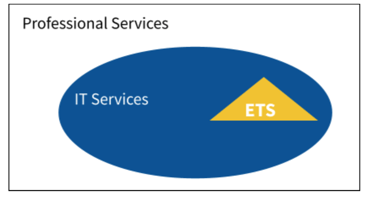Since we posted our first blog introducing Vixul , we have received several comments and questions...
Six Reasons Your Technology Services Firm Needs A Horizontal Position
%20(8).png?width=1920&height=1080&name=Q423%20Blog%20images%20(1920x1080)%20(8).png)
One of the first questions tech services founders face when deciding on their strategic positioning is if they want to target a particular type of industry (vertical positioning) or what they do that can be sold across industries (horizontal positioning). Thought leaders on positioning recommend both vertical and horizontal positioning but usually prefer a solid vertical positioning. But most of these thought leaders aren't speaking from a tech services perspective. As an accelerator dedicated to early-stage tech services firms our opinion is differnt. We believe a horizontal positioning is a must-have for tech services companies. This is because:
- Most technology and technology services are bought and sold by horizontal
- Tech is one level away from business value
- A horizontal focus makes it easier to Climb the ladder to large enterprise
- It open opportunities to capitalize on technology disruptions
- GSIs acquire capabilities
- Platform partners are great allies
Tech Is Bought And Sold By Horizontal
For better or worse, despite all the talk about elevating CTOs and CIOs to talk business, the truth is that tech is usually bought and sold by technology horizontals. Usually, the discussion concerns the tech problem solved, not the value created. Staffing decisions are also made around the particular tech platform.
This is the key to understanding the problem tech services companies face. Most technology is bought by technologists who have broken down the problem into the particular technology they need to solve it. When selling, it is always easier to sell something that people are looking to buy. By this definition, while you will relate to the value delivered to win the business, you must have an attractive horizontal positioning to start the conversations.
Tech Is One Level Away From Business Value
I disagree with the way tech is sold, and I believe all technologists should elevate themselves to understand better the business problem being solved and the value being provided. But there is a reason tech is frequently sold horizontal first. And that is because much of the technology sold is very far removed from the money from the customer. Tech must bring together multiple pieces of the puzzle before realizing business value. And both the buyer and seller may have a deeper understanding of the particular piece of the puzzle being solved than the larger picture. Hence, while industry-vertical-specific information is important, the horizontal technology focus is essential.
For example, in our previous company, Flux7, we were not positioned vertically but had a powerful horizontal positioning. However, our unique value proposition (UVP) was to improve developer productivity. This UVP made us far enough from the money that we could have penetration without committing ourselves to one industry vertical. We still benefitted in healthcare and retail from our extensive experience in those domains, and we might have done better if we had fully committed to one of those sectors. However, we won many Fortune 100 clients without any previous relationships because they knew we were the best for containerization on the cloud.
A different example is one of the companies I'm advising that is still at a seed stage. They are bringing in their expertise in the tech side of revenue ops. They are far more closely aligned with getting customers, and their customers' problems will be far more closely aligned with how money comes into the organization. So, while in the seed stage, they are doing some exploration, I anticipate they will need to focus on an industry vertical soon.
Climbing The Ladder To Large Enterprise
Contradicting the previous point, I agree it is better to be closer to the money. One of our best-performing portfolio companies, The Working Town, is doing so because they directly open new markets for their clients. However, most early-stage tech services get closer to money without a horizontal focus by being the end-to-end provider for startups. To do this, they have to perform multiple very different functions and won't be able to excel at any of them. The problem with this approach is that your journey to get upmarket becomes very slow since you aren't exceptional in any area, and it becomes easier for customers to choose their existing vendors rather than take a risk with you. As a tech services company, the upmarket customers are the ones that pay the best gross margins, so your entire growth journey becomes slow.
If you are focused on a particular horizontal, you can become the best in the world in that specialty. You will displace entrenched incumbents in your specialty. This will allow you to go upmarket and charge premium rates for a rare skillset. The high gross margins will give you the resources to grow fast.
Capitalize On Technology Disruptions
A significant part of the emerging technology services thesis is that emerging technologies carry a wake of disruption and growth behind them. A tech services founder should position themselves to take advantage of emerging technologies to find underserved, high-growth opportunities in emerging technologies. And these disruptive technologies will create their own horizontals. While you can still further refine this focus, in verticals for a tech services company, disruptive technologies are a tremedous horizontal opportunity, more than any vertical positioning in established markets will provide. Based on this opportunity, founders can quickly create a high-margin Rocket Science or a Gray-hair services practice.
GSIs Acquire Capabilities
Many founders don't want to think about acquisition. But the truth is this is something every founder should think about. Regardless of their overall ambition, having a life-changing exit would give them the freedom to take risks and achieve more fulfilling goals. We highly recommend considering acquisition offers in your entrepreneurial journey. And when considering acquisitions, GSIs are large and can service all verticals. However, emerging technologies pose a threat to them. Under the Innovator's Dilemma the GSIs will find they have gaps in their horizontal capabilities because of disruption, and they need to acquire capabilities to protect their revenue quickly. So, GSIs will be ready to pay very well for horizontal capabilities in emerging technologies.
Emily Lewis-Pinnell describes an acquirer motivation for buying a tech services company
Platform Partners Are Great Allies
I am returning to how tech is bought and sold by horizontal and the needs of the GSIs to acquire capabilities. The relationships with the platform partners are a critical opportunity that is not present in other industries. Since tech is sold by the horizontal, many buyers of tech services will go to the tech platform to get references for partners. Because of this early platform, partner relationships can be invaluable. In addition, these relationships constitute an asset for service companies. Platform partner relationships are a part of the capabilities the GSIs are seeking.
Takeaway For Your Business
In closing, horizontal positioning offers tech services companies a unique advantage, allowing them to tap into emerging technologies and broader market opportunities. By focusing on horizontal capabilities, founders can drive growth and become attractive acquisition targets for GSIs, all while staying agile in a fast-evolving industry. This is why technology needs to feature in your positioning statement and elevator pitch when we talk about positioning. Check out the webinar by Vixul co-founder and Managing Partner Aater Suleman on "Positioning In Tech Services" to learn more about how to position your tech services startup.




